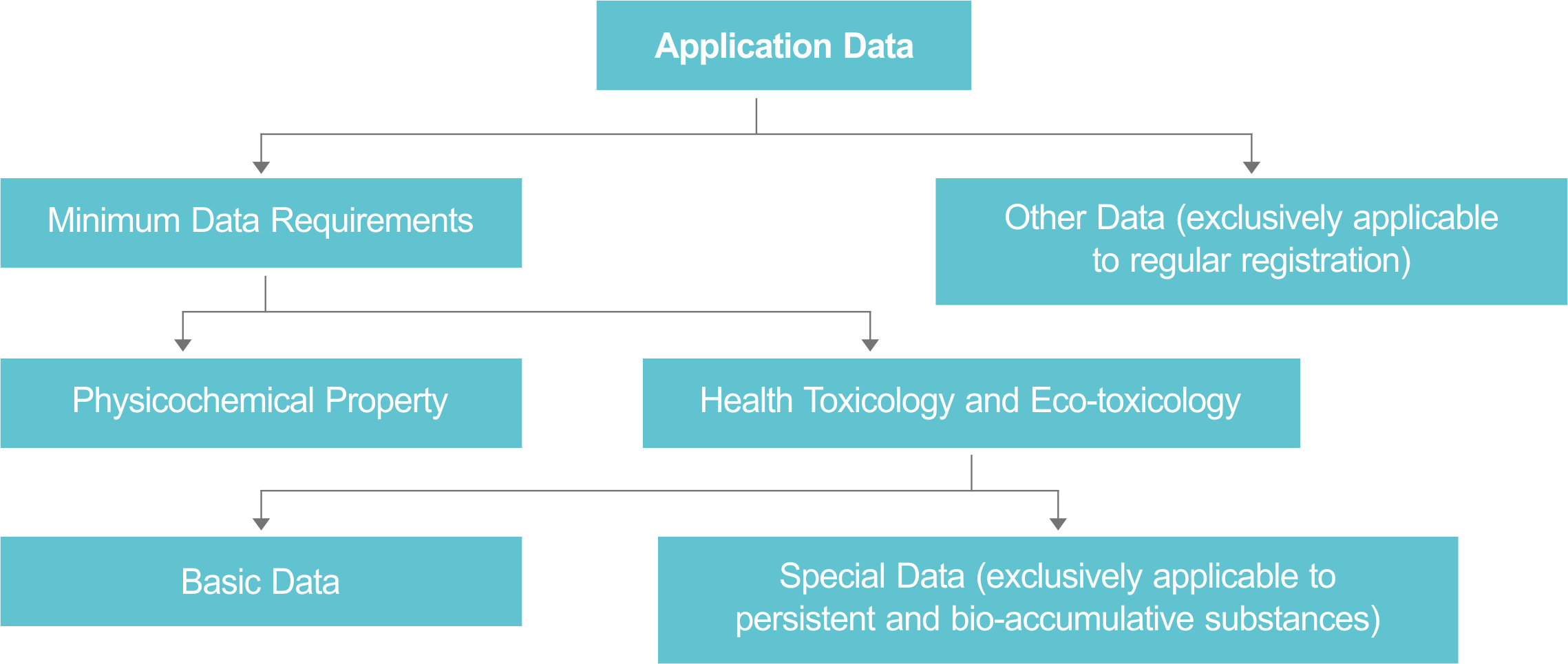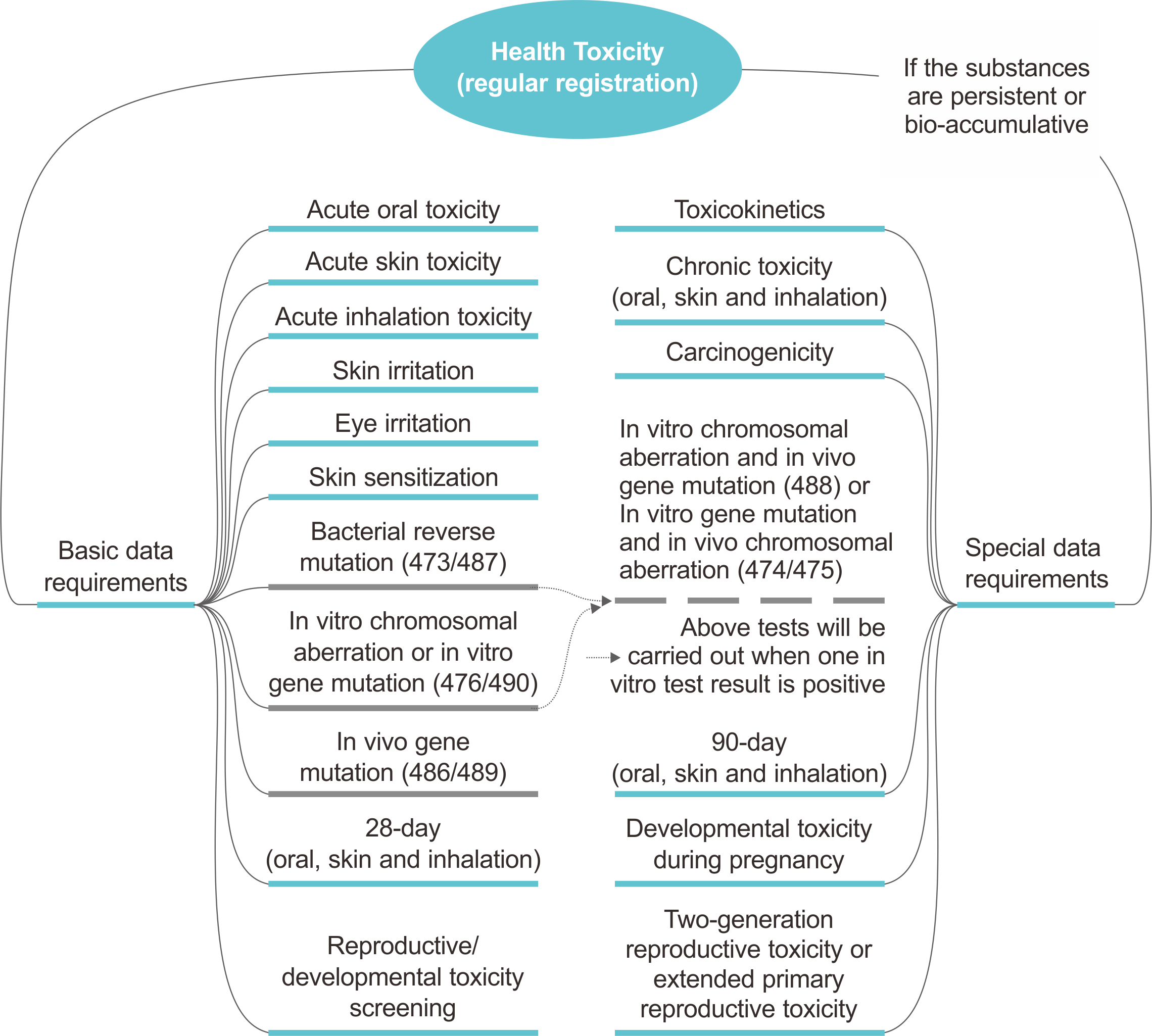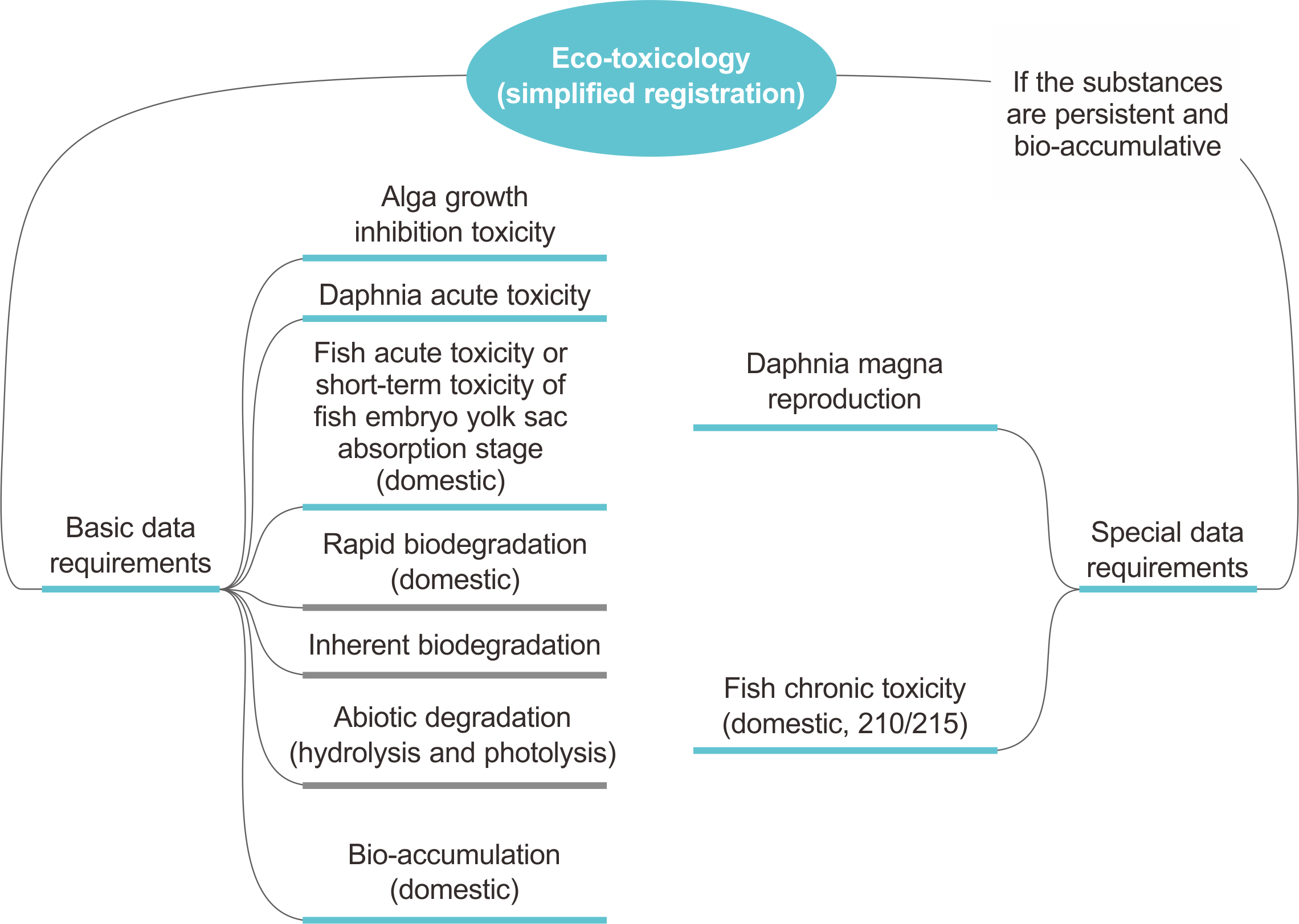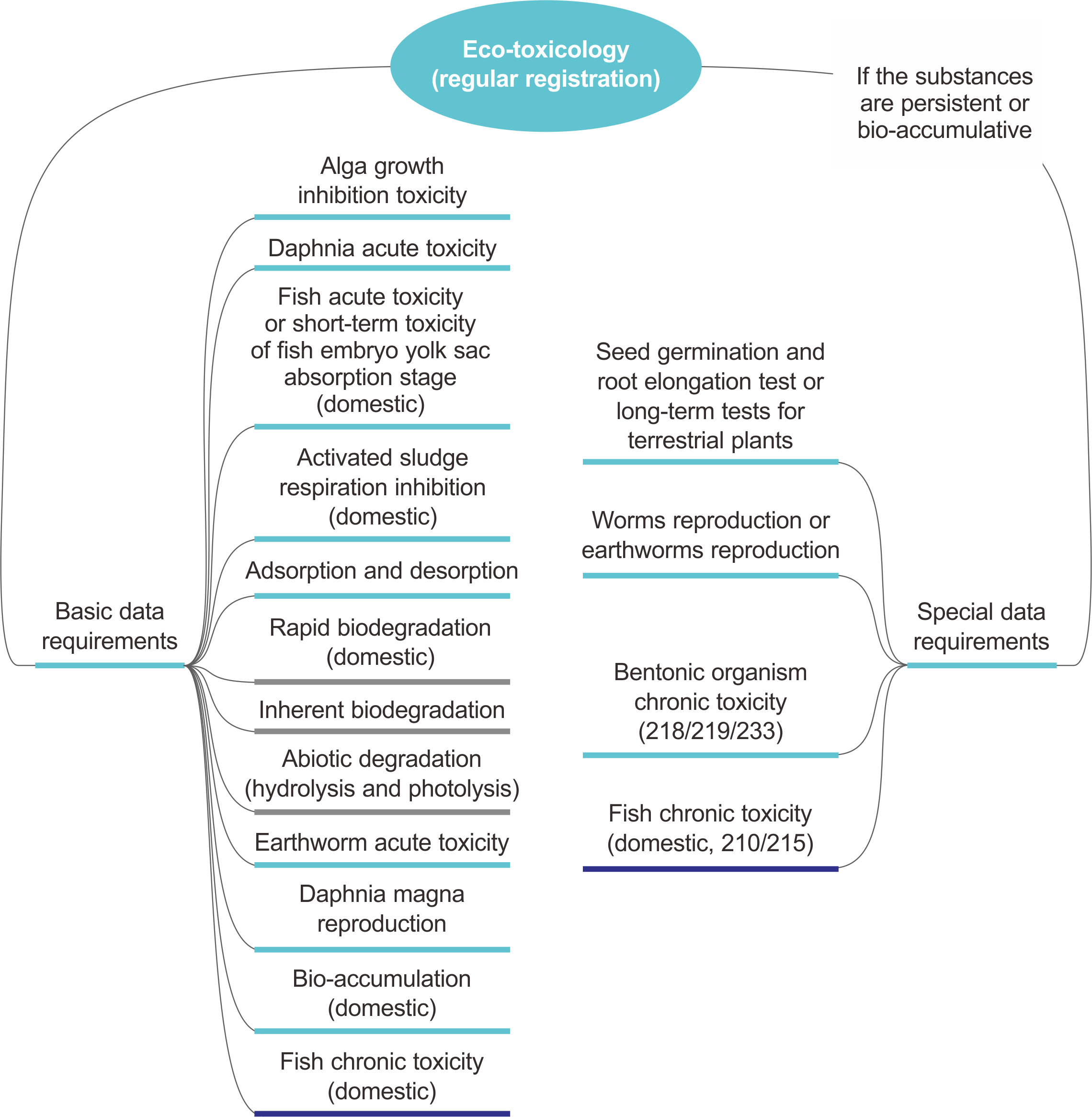The Revised Provisions on Environmental Administration Registration of New Chemical Substances (MEE Order No. 12) was released on 29 Apr. 2020 and will be implemented from 1 Jan. 2021.
To help applicants and representatives complete new chemical substance notification in China, the competent authority has revised the Guidance Documents for New Chemical Substance Notification (hereinafter referred to as the Guidance Document).
In order to make enterprises better understand the Guidance Documents, CIRS has explained some important revisions on data requirements as follows:
1. The Framework for Data Requirements:

- The registration data covers minimum data requirements and other data.
- Applicants of regular and simplified registration shall at least submit minimum data as required (data from the testing report).If the minimum data is not enough to assess the environmental risks of the substances subject to regular registration, then the applicants shall submit other data (data from testing reports is preferred).
- In special cases where testing is not possible, non-testing data originated from QSAR, read-across as well as data from authoritative literatures or databases can also be used (reason, the method applied, and the source of data shall be given).
- The minimum health and eco-toxicological data requirements cover: basic data and additional data. The basic data can be used to judge if the substance is persistent (P) or bio-accumulative (B). If the substance is considered persistent or bio-accumulative, then additional data is also required.
- If the substance meets the conditions for record, then there is no data requirement (except GPC chromatogram for polymers)
2. Minimum Data Requirements
- Regular Registration (10t/a or more): Basic data includes physicochemical properties, health toxicology and eco-toxicology. If the substances are considered persistent or bio-accumulative, then additional data for health toxicology and eco-toxicology is required.
- Simplified Registration (1 t/a or more, yet less than 10t/a): Basic data includes physicochemical properties, persistence, bio-accumulation and acute toxicity of aquatic environment; If the substances are considered persistent and bio-accumulative, then additional data for chronic toxicity of aquatic environment is also required.
(1) Physicochemical Property Data
The physicochemical data will be used in regular registration and simplified registration.
Applicants of regular registration and simplified shall submit the physicochemical data of new substances based on the physical state of the substance at normal temperatures and pressures (20℃, 101.3kPa).
Physical State | Registration Type | Data Requirements |
Solid-state | Regular registration | Chromatogram, melting point/freezing point, density, water solubility, n-octanol/ water partition coefficient, particle size, stability in organic solvent and characteristics of degradation products, dissociation constant and Henry constant |
Simplified registration | Chromatogram, melting point/freezing point, density, water solubility, n-octanol/ water partition coefficient | |
Liquid-state | Regular registration | Chromatogram, melting point/freezing point, boiling point, density, vapour pressure, water solubility, n-octanol/ water partition coefficient, PH value, surface tension, stability in organic solvent and characteristics of degradation products, dissociation constant and Henry constant |
Simplified registration | Chromatogram, melting point/freezing point, boiling point, density, vapour pressure, water solubility, n-octanol/ water partition coefficient, PH value | |
Gas-state | Regular registration | Chromatogram, water solubility, critical point, Henry constant |
Simplified registration |
(2) Health Toxicological Data
Applicants of regular registration shall submit health toxicological data. Details are as follows:

(3) Eco-toxicological Data
The eco-toxicological data will be used in regular registration and simplified registration. The eco-toxicological data requirements for simplified registration are:

The eco-toxicological data requirements for regular registration are:

3. Judgment of PBT and vPvB Substances
According to the Guidance Document, enterprises can judge whether the substances are PBT or vPvB based on GB/T 24782, and whether the substances are classified as substances with environmental and health risks based on GB 30000.
The judgment criterion below is applicable to all organic compounds, including metalloorganic compound:
The Judgment Criterion for PBT and vPvB Substances | |
P | Substances with rapid biodegradability, the substances are not persistent (P) or very persistent (vP); 302B 7d biodegradation rate≥70%, or 302C 14d biodegradation rate ≥70%, the substances are not persistent (P); If substances can be hydrolyzed or photolyzed, the substances are not persistent (P); |
B | log Kow≤4.5, the substances are not bio-accumulative (B) or very bio-accumulative (vB); log Kow>4.5, the substances are potentially bio-accumulative (B); BCF>2000, the substances are bio-accumulative (B); BCF>5000, the substances are very bio-accumulative (vB); |
T | Aquatic acute toxicity EC50 or LC50<0.1mg/L, the substances are potentially toxic; Aquatic acute toxicity EC50 or LC50<0.01mg/L, the substances are toxic; Aquatic chronic toxicity NOEC or EC50<0.01mg/L, the substances are toxic; Carcinogen 1A or 1B, the substances are toxic; Mutagen 1A or 1B, the substances are toxic; Reproductive toxicity 1A, 1B or Category 2, the substances are toxic; Specific target organ toxicity (repeated exposure) category 1 or 2, the substances are toxic; |
4. Data Exemption Conditions
The data exemption conditions in the Guidance Documents are similar with that in the Notice of adjustment to the data requirements for new chemical substance notification released on 31 Aug. 2019. But there are still some differences:
- Exemption clauses on autoignition temperature, flash point, oxidability, inflammability and explosibility are deleted;
- Exemption clauses on dissociation constant, stability in organic solvent and characteristics of degradation products and sediment-water chironomid chronic toxicity are added;
- Substances exclusively used as intermediates can be exempted from chronic toxicity test;
- Fish 14-day prolonged toxicity test is deleted;
- Long-term earthworm toxicity tests will be carried to assess terrestrial toxicity, and soil microbial influence test is deleted;
- Earthworm acute toxicity test will not be exempted when the water solubility >1mg/L or the logKoc <3.5;
Summary
The data requirements in the Guidance Documents have been dramatically adjusted. It sets special requirements for PBT/vPvB substances. CIRS warmly reminds that enterprises should pay attention to the changes and strengthen the evaluation on substances before registration. CIRS will continue to focus on updates to the Guidance Documents and provide professional interpretations and regulatory compliance suggestions to enterprises.
If you have any needs or questions, please contact us at service@cirs-group.com.
CIRS is to host a free webinar to give an interpretation to the draft Guidance Documents for New Chemical Substance Notification and provide the countermeasure proposals on 17 Sep. 2020. The webinar will be given in English, Chinese and Japanese. If you would like to know more info about the free webinar, please click here.
Reference:


